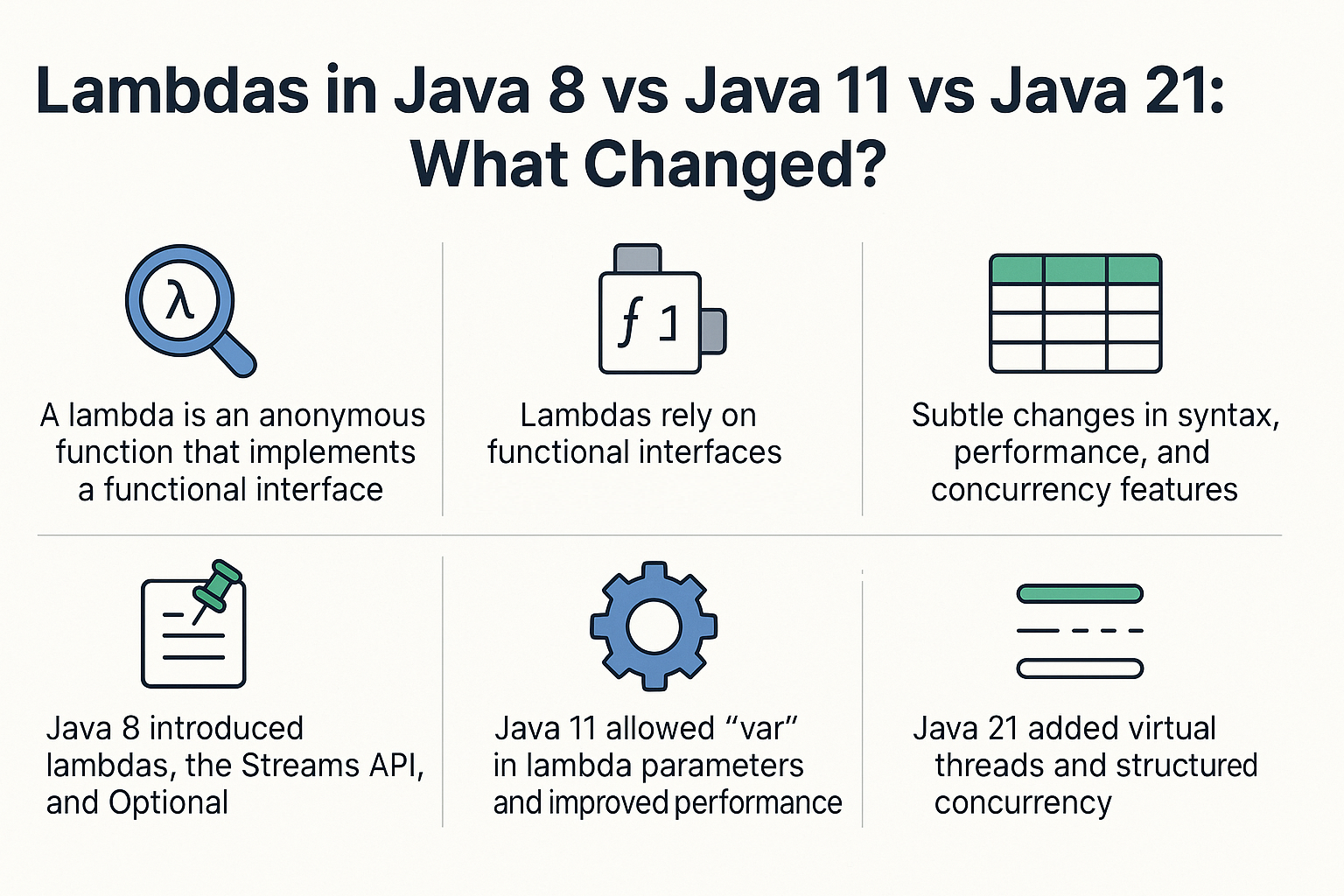Since their introduction in Java 8, lambda expressions have revolutionized the way developers write Java. They enable cleaner, more expressive code and are deeply tied to Java’s functional programming capabilities.
But the evolution didn't stop there. Each new Java release—especially Java 11 and Java 21—has introduced subtle yet impactful changes that enhance how lambdas are used in real-world development.
This guide compares lambdas in Java 8, 11, and 21, exploring syntax changes, performance improvements, and practical use cases in modern Java development.
🔍 What Are Lambda Expressions?
A lambda is an anonymous function that implements a functional interface. It enables passing behavior as data.
Function<String, Integer> length = s -> s.length();
This short syntax replaces verbose anonymous inner classes and supports declarative logic composition.
🧱 Functional Interface Foundation
Lambdas require functional interfaces—interfaces with a single abstract method.
Examples:
Runnable–void run()Callable<T>–T call() throws ExceptionFunction<T, R>–R apply(T t)Predicate<T>–boolean test(T t)Consumer<T>–void accept(T t)Supplier<T>–T get()
📊 Comparison Table: Java 8 vs 11 vs 21
| Feature | Java 8 | Java 11 | Java 21 |
|---|---|---|---|
| Lambda introduction | ✅ Yes | ✅ Yes | ✅ Yes |
| Local variable type inference in lambdas | ❌ No | ✅ var in parameters |
✅ Enhanced via preview features |
| Streams API | ✅ Introduced | ✅ Minor enhancements | ✅ Enhanced performance + parallelism |
| Virtual threads | ❌ No | ❌ No | ✅ Project Loom (ideal for lambda use) |
| Structured concurrency | ❌ No | ❌ No | ✅ Scoped values + structured tasks |
| Pattern matching support | ❌ No | ✅ Initial preview (Java 16+) | ✅ Stable and enhanced |
| Performance optimizations | Basic | Better JIT/inlining | Improved with Loom + GC tuning |
⚙️ What’s New in Each Version?
📌 Java 8 Highlights
- First release with lambdas
- Introduced
java.util.function - Streams API and
Optional CompletableFuturefor async
📌 Java 11 Enhancements
- Local variable syntax (
var) allowed in lambda parameters
Function<String, String> trim = (var s) -> s.trim();
- Better performance (JIT enhancements)
- Cleaner APIs and extended
Optional
📌 Java 21 Features
- Virtual Threads (Project Loom): Ideal for lambdas in async/multi-threaded apps
- Structured Concurrency: Enables scoped tasks and context propagation
- Scoped Values: Functional-friendly alternative to ThreadLocal
- Improved GC and performance for functional-style code
🔧 Real-World Lambda Use Cases
1. Functional Composition
Function<String, String> trim = String::trim;
Function<String, String> upper = String::toUpperCase;
Function<String, String> combined = trim.andThen(upper);
2. Collection Filtering and Mapping
List.of("a", "bb", "ccc").stream()
.filter(s -> s.length() > 1)
.map(String::toUpperCase)
.forEach(System.out::println);
3. Async Logic with Lambdas (Java 21 Virtual Threads)
try (var scope = StructuredTaskScope.ShutdownOnFailure.of()) {
scope.fork(() -> fetchData());
scope.join();
}
Lambdas work naturally with virtual threads and structured concurrency models.
🔐 Checked Exceptions: Still a Challenge
Lambdas can't throw checked exceptions unless:
- You use a functional interface that declares them (like
Callable) - Or wrap them in runtime exceptions
Function<String, Integer> parseSafe = s -> {
try {
return Integer.parseInt(s);
} catch (NumberFormatException e) {
return 0;
}
};
🔄 Method References vs Lambdas
| Expression | Meaning |
|---|---|
s -> s.length() |
Lambda |
String::length |
Method reference |
this::process |
Reference to instance method |
Use method references when lambdas only delegate existing methods.
🚫 Anti-Patterns to Avoid
- Overusing chaining without naming intermediate steps
- Mutating shared state inside lambdas
- Handling complex logic inline
- Ignoring null checks when using streams
🧪 Functional Patterns Enhanced by Java 21
- Builder: Chain lambda configurators
- Command: Lambdas as encapsulated actions
- Strategy: Inject lambdas to vary logic
- Observer: Subscribe using
Consumer<T>instances
✅ Conclusion and Key Takeaways
- Java 8 introduced lambdas and changed Java forever
- Java 11 enhanced them with
var, better inference, and performance - Java 21 makes them even more powerful via virtual threads and structured concurrency
- Embrace lambdas where they increase clarity and reusability
- Stay aware of limitations (checked exceptions, debugging) and use best practices
❓ FAQ
1. Do lambdas replace all anonymous classes?
Only when a single abstract method exists. Multiple-method interfaces still need classes.
2. Can I use var with lambdas in Java 11?
Yes. (var s) -> s.length() is valid and helps with annotations.
3. Are lambdas optimized by the JVM?
Yes, lambdas are compiled into invokedynamic calls and optimized at runtime.
4. What is the benefit of virtual threads for lambdas?
You can write concurrent logic using lambdas without managing heavyweight threads.
5. Can lambdas be serialized?
Not reliably. Avoid serialization unless you use specialized libraries or frameworks.
6. Is Function<T, R> preferred over custom interfaces?
For general-purpose transformations, yes. Use custom interfaces only for domain-specific logic.
7. Are lambdas garbage collected?
Yes. They are objects on the heap like any other reference.
8. Can lambdas lead to memory leaks?
Only if they capture heavy closures or references unnecessarily.
9. Are method references faster than lambdas?
Not significantly. They're cleaner but semantically equivalent.
10. What's the biggest reason to upgrade to Java 21 for lambdas?
Structured concurrency + virtual threads make lambdas more scalable in modern apps.
